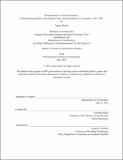“Professionals in a Soviet America” Federal Housing Policy, the Popular Front, and Architects in Los Angeles, 1919–1947
Author(s)
Heard, James
DownloadThesis PDF (74.77Mb)
Advisor
Dutta, Arindam
Terms of use
Metadata
Show full item recordAbstract
In the wake of the first Red Scare, Marie Meloney, editor of the women’s magazine “The Delineator,” founded Better Homes in America, a national organization to promote the ideal American home through publications, model homes, and local events. Herbert Hoover, the then-Secretary of Commerce, served as the organization’s first president, operated it as the propaganda wing of the United States’ Commerce Department, and relied on it to rhetorically hitch “American values” to detached, single-family dwellings. After becoming President in 1929, Hoover began to intervene in housing through increasingly direct measures. The complementary trajectories of propaganda and policy coincided at the President’s Conference on Home Building and Home Ownership in 1931, out of which the Federal Home Loan Bank Act was drafted, legislatively establishing the national framework for mortgage lending and normalizing the detached single-family dwelling. This conjunction of form and finance reverberated through congressional discourse and eventually influenced housing restrictions established through the Federal Housing Administration—particularly racial, formal, and stylistic controls.
By the mid-1930s, galvanized by the Great Depression, the Communist Party USA had started organizing a left-liberal Popular Front with architects figured as a vanguard of the professional class. Over the following decade, this network challenged the increasingly hegemonic suburban model of housing. This included labor unions like the Federation of Architects, Engineers, Chemists, and Technicians union, which agitated for public works provisions in New Deal policy and the Hollywood Independent Citizens Committee of the Arts, Sciences, and Professions, a cultural organization that incited architects—alongside other professionals—to protest for an alliance between the United States and the Soviet Union, global nuclear disarmament, and modern housing throughout California. As the second Red Scare accelerated in the postwar period, institutions like the First Unitarian Church of Los Angeles intervened to provide meeting spaces for embattled organizations. While the Popular Front coalition in Los Angeles unravelled by the mid-1950s under the burden of state and federal surveillance, it left behind a built legacy of politically motivated developments throughout the city.
Date issued
2022-05Department
Massachusetts Institute of Technology. Department of ArchitecturePublisher
Massachusetts Institute of Technology